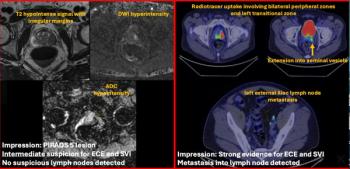Can MRI Have an Impact with Fertility-Sparing Treatments for Endometrial and Cervical Cancers?
In a literature review that includes insights from recently issued guidelines from multiple European medical societies, researchers discuss the role of magnetic resonance imaging (MRI) in facilitating appropriate patient selection for fertility-sparing treatments to address early-stage endometrial and cervical cancer.
Magnetic resonance imaging (MRI) may play a significant role in determining whether patients with early-stage endometrial or ovarian cancer are appropriate candidates for fertility-sparing treatments.
In a new literature review, published by the
1. For assessment of tumor size in patients with cervical cancer, the researchers cautioned that
2. Axial T1-weighted pelvic MRI with a large field of view (FOV) is recommended for the exclusion of bone lesions and enlarged pelvic lymph nodes (LNs) in patients with cervical cancer and those with endometrial cancer, according to the review authors.
3. In order to facilitate comparison with high-resolution, small FOV T2-weighted MRI, the researchers recommend obtaining axial oblique, small FOV pelvic DWI in patients with cervical cancer or endometrial cancer.
(Editor's note: For additional content on MRI, click
4. Emphasizing that parametrial invasion is a contraindication for fertility-sparing treatment in patients with cervical cancer, the review authors noted that the combination of T2-weighted MRI and DWI has an 82 percent sensitivity and 97 percent specificity for detecting parametrial invasion.
5. In order to rule out myometrial invasion in patients with endometrial cancer, the researchers point out the combination of T2-weighted MRI, DWI and dynamic contrast-enhanced (DCE) MRI offers pooled sensitivity and specificity rates of 81 and 91 percent respectively.
6. Coronal or axial abdominal T2-weighted MRI with a large FOV can exclude hydronephrosis and enlarged para-aortic LNs in patients with endometrial or cervical cancer, according to the review authors.
7. For patients with endometrial cancer, the researchers said the use of high-resolution T2-weighted MRI — including turbo-spin echo (TSE) and fast-spin echo (FSE) sequences) — can help exclude myometrial invasion, cervical stromal invasion, and ovarian involvement.
Newsletter
Stay at the forefront of radiology with the Diagnostic Imaging newsletter, delivering the latest news, clinical insights, and imaging advancements for today’s radiologists.





























